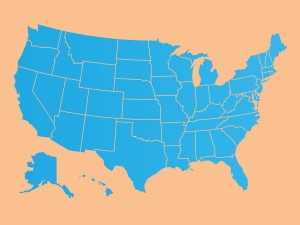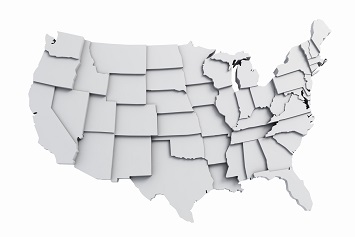The current administration’s two-part rulemaking to first rescind and then replace the prior administration’s Clean Water Rule to define the Clean Water Act (CWA) term Waters of the United States ((WOTUS rule), June 29, 2015, Federal Register (FR)) derives from two positions.
First, the administration and the two agencies charged with the rulemaking—the EPA and the U.S. Army Corps of Engineers (Corps)—assert that the WOTUS rule provided a definition that included types of waters that Congress did not intend to fall under federal jurisdiction (that is, those that are not “relatively permanent, standing or continuously flowing bodies of water”). Second, the EPA/Corps assert that the 2015 rule deviates from federalism, the principle whereby the federal government and the states share governance. Federalism is inherent throughout the Constitution (although the word does not actually appear in the Constitution); for example, the 10th Amendment says that powers not specifically designated to the federal government and not prohibited to the states can be lawfully assumed by the states. The CWA makes this shared responsibility more explicit, stating in its second paragraph:
“It is the policy of the Congress to recognize, preserve, and protect the primary responsibilities and rights of States to prevent, reduce, and eliminate pollution, to plan the development and use (including restoration, preservation, and enhancement) of land and water resources, and to consult with the [EPA] Administrator in the exercise of his authority under this chapter.”
If the first part of that sentence is a clear and strong recognition of states’ rights regarding control of their water resources, the second part also affords some level of involvement and rights to the federal government over what the states may do regarding those resources. Unfortunately, the remainder of the CWA and at least three U.S. Supreme Court decisions do not fully clarify where federal CWA authority ends and state authority begins (or vice versa).
The 2015 WOTUS rule attempted to resolve the uncertainty by pushing the needle to the federal side. It would seem from statements by EPA Administrator Scott Pruitt that the current administration is inclined to pushing the needle to the side of the states.
The two-part rulemaking also responds to an Executive Order (EO) from President Donald Trump, which directs that the EPA/Corps review the 2015 rule in light of the “national interest to ensure that the Nation’s navigable waters are kept free from pollution, while at the same time promoting economic growth, minimizing regulatory uncertainty, and showing due regard for the roles of the Congress and the States under the Constitution.” In addition, the EO tells the agencies to “consider interpreting the term ‘navigable waters’ in a manner consistent with the opinion of Justice Antonin Scalia in Rapanos v. United States (U.S. Supreme Court 2006).
Stakeholder Feedback
As part of its rulemaking outreach, the EPA/Corps undertook a “federalism consultation” wherein stakeholders were asked to provide their views on what a new WOTUS definition should be and the extent to which federalism should be factored into that definition. The EPA/Corps report that they received 169 letters as part of the consultation process, including 16 individual letters from 19 state governors, 2 letters from lieutenant governors, 1 letter from a state senator, 1 letter signed by 20 attorneys general, 63 letters from state agencies and offices, 70 letters from local governments, 10 letters from water districts, and 6 letters from state and professional associations. Most of these letters are available here.
We here provide a selection of excerpts from state officials to reflect a range of views.
“As an initial matter, I firmly believe that individual states should be given the necessary discretion to determine how to regulate development activities within their borders. Each state is unique, and the needs of a small and rural state such as New Hampshire are bound to be different from those of larger and more developed states. Federal involvement should be reserved for the relatively few projects that have the potential to impact interstate commerce.” -Christopher T. Sununu, Governor, New Hampshire
“New York supports national rules to protect waters, including wetlands, which establish a consistent and strong national regulatory floor. For states like New York, with strong existing programs, a sound national rule and inventory of federally protected ‘waters of the United States’ is necessary to ensure a level playing field between states.” -Basil Seggos, Commissioner, New York State Department of Environmental Conservation
“To achieve the Clean Water Act goals, states must have flexibility to adapt federal programs based on the nature of the water resources within their jurisdictions. To the contrary, your agencies suggest defining ‘relatively permanent’ waters as only perennial streams, or perennial streams plus other streams with some measure of seasonal flow. These one-size-fits-all approaches fail to consider the wide variety of stream functions that exist in natural systems.” -Patrick McDonnell, Secretary, Pennsylvania Department of Environmental Protection
“The states are important partners with EPA in implementing the CWA. This rule is also important to states because it will define where federal authority to regulate ends and where exclusive state authority over waters begins. In promulgating the current rule, which was completed in 2015, EPA all but ignored states’ interests. Involving the states from the beginning, as you are doing with this rulemaking effort, is essential.” -Scott G. Mandirola, Deputy Secretary, West Virginia Department of Environmental Protection
“The opportunity now exists for the Agency to craft a rule that avoids such a massive expansion of federal jurisdiction. The new rule can be drafted with clearly defined and appropriately limited jurisdiction based on the recognition that states also regulate and protect waters and wetlands. The Clean Water Act was drafted so that the USEPA and the Army Corps of Engineers have limitations on their jurisdiction in regard to water and wetlands. It is not necessary for the Agencies to have almost universal jurisdiction, with the concomitant regulatory cost impacts, for water and wetlands within states to be protected. States retain the ability and responsibility to protect water and wetlands within their boundaries. Federal jurisdiction must be limited to allow states to exercise their authority and abilities, and address water resource issues unique to each state.” -Steven Dwinell, Director, Florida Department of Agriculture and Consumer Services

“States’ statutory authority should be considered in a new rule. For example, Mississippi has statutory authority to establish the minimum flow requirements in waters of the state and is solely responsible for determining the appropriate flow regimes in streams. The federal definition of ‘Waters of the United States’ should not infringe on that authority.” -Phil Bryant, Governor, Mississippi
“[When developing the definition of WOTUS, the EPA/Corps should] allow states the flexibility to regulate the waters necessary to achieve the goals of the Clean Water Act and in a manner that ensures the health, safety, and economic prosperity of their citizens.” -Michael S. Regan, Secretary, North Carolina Department of Environmental Quality
“We strongly urge the USEPA to work closely with states like Michigan, who have successfully implemented the Clean Water Act Programs for decades, to develop a new waters of the United States rule. This initial consultation with the states and tribes should be the beginning of the cooperative federalism process, not the end; and we encourage the USEPA to share draft language with states and tribes as specific rule language is considered.” -C. Heidi Grether, Director, Michigan Department of Environmental Quality
“We particularly commend the effort EPA and the Corps is making to perform a true federalism review and engage the States, as co-regulators, in development of any revised rule language.” -Bruno L. Pigott, Commissioner, Indiana Department of Environmental Management
“[I]n recognizing the States’ primary role in water resource management and to achieve regulatory certainty, the U.S. EPA and the U.S. ACE [Army Corps of Engineers] should investigate the possibility of developing, through the revised definition of ‘waters of the United States,’ specific criteria to be used in determining whether a water body is considered a jurisdictional tributary to a [traditional navigable water] and, therefore, a jurisdictional water covered by the CWA. Importantly, in developing this new definition, the ability to develop specific criteria that could be used by the States to map and/or formally designate non-navigable tributaries that meet the revised definition within each respective State should be explored.” -Michael Teague, Secretary, Oklahoma Secretary of Energy and Environment
“I urge EPA to create clear, administrable definitions and respect state authority while furthering the mission of protecting clean water. Protecting exemptions for agricultural operations through a scientifically sound approach is imperative. It is important for EPA to examine and minimize the impact that new definitions have on our state permitting programs, conservation efforts, and agricultural community.” -Sid Miller, Commissioner, Texas Department of Agriculture
“Nebraska, like other states, clearly has the authority to protect waters of the state. Principles announced by Justice Scalia would exclude from federal jurisdiction waters that are properly under state control, such as groundwater, agricultural waters including farm ponds, stock ponds, and irrigation ditches, and man-made dugouts, pits, and ponds used for irrigation where not connected to jurisdictional surface waters. Although these waters fall outside federal jurisdiction, it does not mean that the waters are unregulated—our state regulatory agencies are well equipped to protect state waters without federal intervention.” -Pete Ricketts, Governor, Nebraska
“One approach to expand State engagement would be to work with the Western States Water Council and the WestFAST [Western States Federal Agency Support Team] team. There are three federal employees that would be key—the EPA and USACE, WestFAST representative, and the WestFAST liaison imbedded with the Council’s staff. Engage these team members directly in the rule making process. The Council would work directly with the WestFAST members to communicate policy direction, raise questions and concerns and provide direct input into rule development. We are confident a subcommittee of Council members could be formed to support this effort and provide a strong sounding board for the many policy matters in question.” -Tom Livers, Director, Montana Department of Environmental Quality
“The revised rule should also clearly identify that states have authority to determine waters regulated under the CWA within non-tribal state boundaries. Determinations of cross-state, tribal, and international waters should continue to be made by the Department of the Army with input from affected states or tribes.” -Douglas A. Ducey, Governor, Arizona
“We recommend that the federal agencies continue to work cooperatively with the States to develop additional regional general permits that address local conditions and provide streamlining and predictability in permitting. These permitting efficiencies can protect our nation’s waters and accommodate the geographic and regional differences among the states that are impractical to address in a nationwide rule.” -Maia D. Bellon, Director, Washington State Department of Ecology
“We also appreciate your emphasis on ‘cooperative federalism’ in this rulemaking process. Alaska has unique characteristics such as permafrost that make our active participation critical to developing a sensible and workable definition of waters of the United States. The State of Alaska has often found itself in an adversarial position with the federal government in the past, fighting to preserve our ability to manage and develop our own lands and resources. We are hopeful that this marks the beginning of a more productive and collaborative relationship that takes into account Alaska’s complex and unique environment.” -Bill Walker, Governor, Alaska

